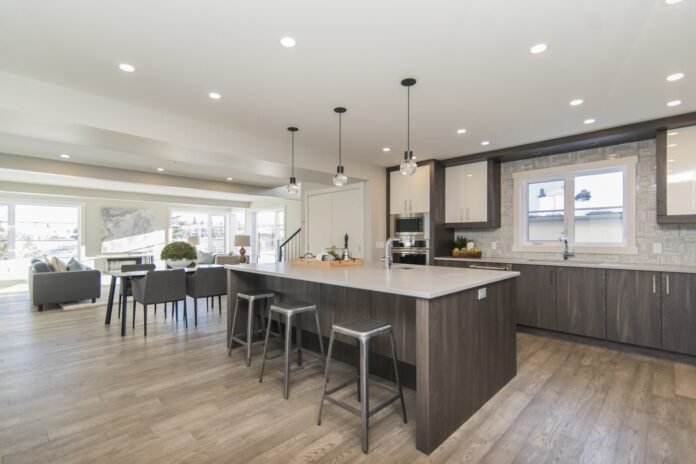The kitchen lights is the heart of every home, where meals are prepared, conversations flow, and memories are made. Proper lighting is essential to ensure functionality, safety, and ambiance. Whether you’re chopping vegetables, hosting guests, or enjoying a late-night snack, the right lighting can transform your kitchen into a warm and inviting space. From task lighting to decorative fixtures, choosing the best kitchen lights depends on layout, style, and personal preference.
1. Importance of Proper Kitchen Lighting
A well-lit kitchen enhances visibility, reduces eye strain, and creates a welcoming atmosphere. Without adequate lighting, tasks like cooking and cleaning become challenging, and the space may feel dull or cramped. Proper illumination also highlights design elements, such as countertops, backsplashes, and cabinetry, adding depth and character to the room. Whether you prefer bright, focused light for food prep or soft, ambient lighting for dining, a layered lighting approach ensures versatility and efficiency.
2. Types of Kitchen Lighting
Kitchen lighting can be categorized into three main types: task, ambient, and accent lighting. Task lighting focuses on work areas like countertops, sinks, and stoves, providing bright, direct illumination for safe and efficient cooking. Under-cabinet lights, pendant lights, and recessed fixtures are popular choices. Ambient lighting serves as the primary light source, often coming from ceiling-mounted fixtures or chandeliers that evenly distribute light. Accent lighting adds a decorative touch, highlighting architectural features or open shelving with LED strips or spotlights. Combining these layers creates a balanced and visually appealing kitchen.
3. Choosing the Right Light Fixtures
Selecting the perfect light fixtures depends on kitchen size, ceiling height, and overall décor. Pendant lights work well over islands and breakfast bars, offering both functionality and style. Flush or semi-flush mounts are ideal for low ceilings, providing ample light without taking up space. Track lighting is versatile, allowing adjustable spotlights to direct light where needed. For a modern look, LED strip lights under cabinets or along toe kicks add a sleek, contemporary touch. Consider energy-efficient options like LED bulbs, which last longer and reduce electricity costs while maintaining brightness.
4. Best Lighting for Small vs. Large Kitchens
Lighting needs vary depending on kitchen size. In a small kitchen, maximizing natural light and using reflective surfaces like glossy backsplashes can make the space feel larger. Recessed lighting or slim-profile fixtures prevent a cluttered look while ensuring sufficient brightness. For larger kitchens, a combination of statement chandeliers, multiple pendant lights, and layered task lighting ensures even illumination without dark corners. Open-concept kitchens benefit from cohesive lighting that blends with adjacent living or dining areas, creating a seamless transition between spaces.
5. Smart Lighting Solutions for Modern Kitchens
Technology has revolutionized kitchen lighting with smart systems that offer convenience and energy savings. Voice-controlled or app-enabled lights allow you to adjust brightness and color temperature with a simple command. Motion-sensor lights are perfect for pantries or under-cabinet areas, activating only when needed. Dimmable fixtures provide flexibility, letting you switch from bright task lighting to a soft glow for evening ambiance. Smart lighting not only enhances functionality but also integrates with home automation systems for a futuristic, efficient kitchen experience.
6. Styling Tips: Matching Lights with Kitchen Décor
Lighting should complement your kitchen’s design theme. For a rustic farmhouse style, wrought-iron chandeliers or vintage Edison bulbs add charm. Minimalist kitchens benefit from sleek, geometric pendants or hidden LED lighting. Industrial designs pair well with exposed bulbs and metal fixtures, while traditional kitchens shine with crystal chandeliers or classic lanterns. The finish of the fixture—whether brushed nickel, matte black, or brass—should harmonize with hardware and appliances for a cohesive look.
Conclusion
The right kitchen lighting enhances both practicality and aesthetics, turning an ordinary cooking space into a dynamic and inviting hub. By understanding different lighting types, selecting suitable fixtures, and incorporating smart technology, you can create a kitchen that is both functional and stylish. Whether you prefer a bright, energizing atmosphere or a warm, cozy glow, well-planned lighting ensures your kitchen meets all your needs while reflecting your personal taste. Invest in quality lighting, and let your kitchen shine in every possible way.


